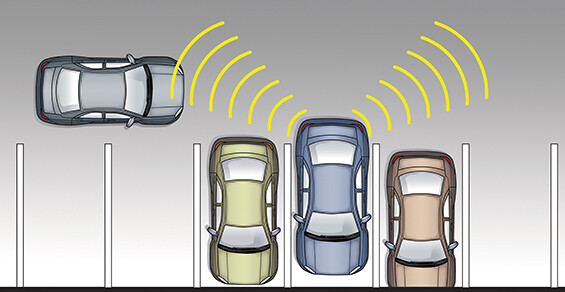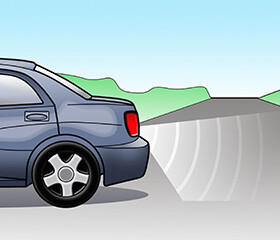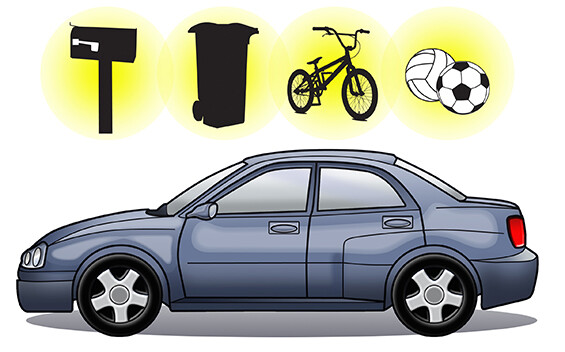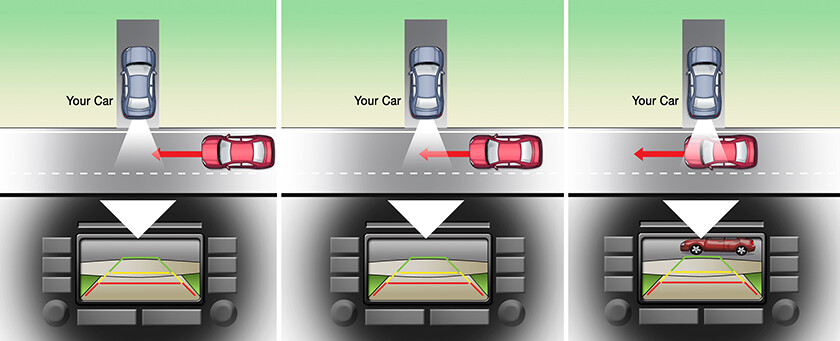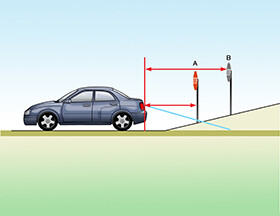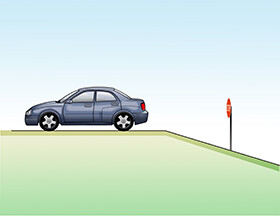Your back-up camera has a limited field of view. It may not see objects below the bumper or under your vehicle. When a child or an object in your back-up camera view suddenly disappears, you should recheck before backing up. They may have entered your back-up camera’s blind spot.
Close Menu
Safety Features
- High Speed Alert
- Adaptive Cruise Control - Quick Guide
- MyCarDoesWhat Animated Logo - Video File
- My Car Does What: Clearing the Confusion
- Non-Occupant Protection
- Your Vehicle in the Mobility System
- Welcome to MyCarDoesWhat.org
- Temperature Warning - With Rick & Scout
- Hill Descent Assist - With Rick & Scout
- Pedestrian & Bicycle Detection - With Rick & Scout
- Forward Collision Warning – With Rick & Scout
- Hill Start Assist - With Rick & Scout
- Drowsiness Alert - Quick Guide
- Adaptive Headlights - Quick Guide
- Parking Sensors - Quick Guide
- Automatic Parallel Parking - Quick Guide
- MyCarDoesWhat PSA (Full)
- Electronic Stability Control (ESC) - Quick Guide
- MyCarDoesWhat PSA (:30)
- MyCarDoesWhat PSA (:15)
- Promo - Adaptive Headlights
- Drowsiness Alert - With Rick and Scout
- Rick & Scout Introduce MyCarDoesWhat.org (TRT 1:22)
- Techspert Morgan Price: Brake Assist
- Private video
- Adaptive Headlights - With Rick and Scout
- Private video
- Promo – Rick & Scout Tease Adaptive Headlights (TRT :24 )
- Automatic Emergency Braking (AEB) - Quick Guide Animation
- Private video
- Electronic Stability Control (ESC) (remove) - With Rick & Scout
- Traction Control - With Rick & Scout
- Push Button Start - Quick Guide
- Parking Assist and More - With Rick and Scout
- 3 Sound Bites – Debbie Hersman, President & CEO, National Safety Council TRT: 1:00 (:15/:12/:14)
- Private video
- Lane Keeping Assist - Quick Guide
- Press Conference
- Private video
- 3 Sound Bites – Daniel McGehee, University of Iowa TRT: 1:19 (:20/:24/:16)
- MyCarDoesWhat Launch Event Live Stream - Oct 7, 2015
- Private video
- Lane Departure Warning - Quick Guide
- Private video
- B-Roll – Safety Features, Driving and Screen Shots (TRT: 8:17)
- Forward Collision Warning - Quick Guide
- Blind Spot Monitor - Quick Guide
- Rear Cross Traffic Alert - Quick Guide
- Back-up Camera – Quick Guide
- Anti-lock Braking System – Quick Guide
- Electronic Stability Control (ESC) - With Rick & Scout
- Traction Control - Quick Guide
- Back-up Warning - Quick Guide
- Sideview Camera - Quick Guide
- Automatic Emergency Braking - Rick & Scout
- Tire Pressure Monitoring System - Quick Guide
- Meet Rick & Scout
- Tire Pressure Monitoring System - With Rick & Scout
- Lane Departure Warning and More - With Rick & Scout
- Forward Collision Warning and More – With Rick & Scout
- Blind Spot Warning Systems - New Car Features with Rick & Scout
- Push Button Start – With Rick & Scout
- Back-up Camera and More - With Rick & Scout
- Adaptive Cruise Control - With Rick & Scout
- Anti-Lock Braking System - With Rick & Scout
- Combined Sound Bites & B-Roll (TRT: 10:12)
- MyCarDoesWhat Sizzle Reel_October 7 2015
- Road to Automation - Motion Graphic with music
- Back-up Camera
- Anti-Lock Braking System
- Blind Spot Warning
- Automatic Emergency Braking
- Lane Departure Warning
- Tire Pressure Monitoring System
- Adaptive Cruise Control
- Adaptive Headlights
- Automatic Parallel Parking
- Automatic Reverse Braking
- Back-up Warning
- Bicycle Detection
- Brake Assist
- Curve Speed Warning
- Drowsiness Alert
- Electronic Stability Control
- Forward Collision Warning
- High Speed Alert
- Hill Descent Assist
- Hill Start Assist
- Lane Keeping Assist
- Left Turn Crash Avoidance
- Obstacle Detection
- Parking Sensors
- Pedestrian Detection
- Push Button Start
- Rear Cross Traffic Alert
- Temperature Warning
- Sideview Camera
- Traction Control


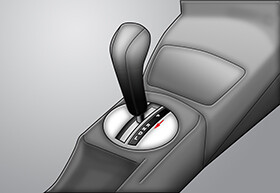 When you shift your car into REVERSE, the back-up camera automatically turns on. A video display shows an image of the area behind your car. This display screen is usually in the rearview mirror or on the dashboard.
When you shift your car into REVERSE, the back-up camera automatically turns on. A video display shows an image of the area behind your car. This display screen is usually in the rearview mirror or on the dashboard.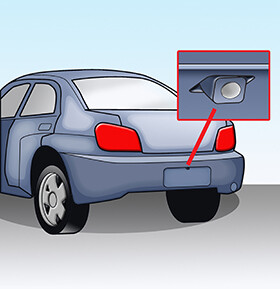 Your back-up camera is located in the rear of your car. It is connected to a display screen that shows you what is happening in the area behind the vehicle.
Your back-up camera is located in the rear of your car. It is connected to a display screen that shows you what is happening in the area behind the vehicle.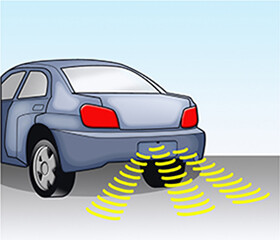 Some back-up camera systems include sensors in the rear bumper. These sensors detect objects behind your car. When an object is detected, your system will provide a warning light and/or a warning sound.
Some back-up camera systems include sensors in the rear bumper. These sensors detect objects behind your car. When an object is detected, your system will provide a warning light and/or a warning sound.